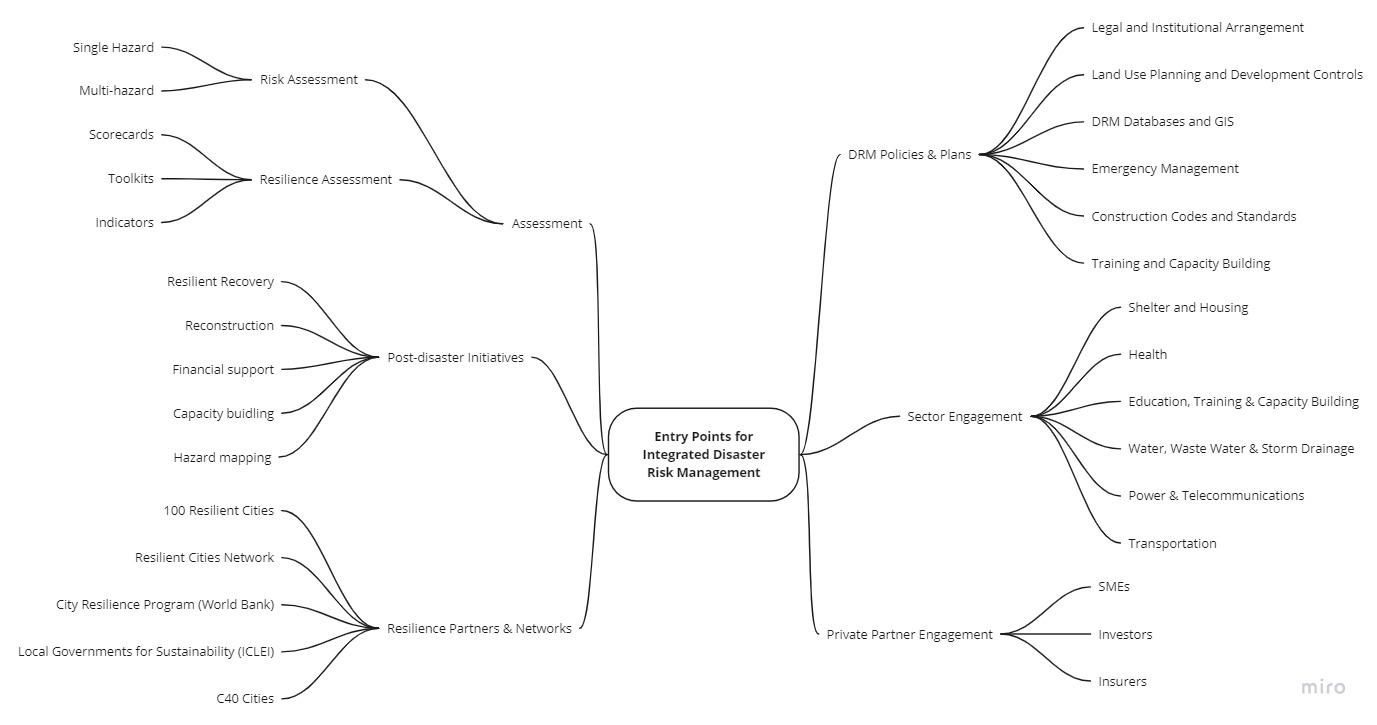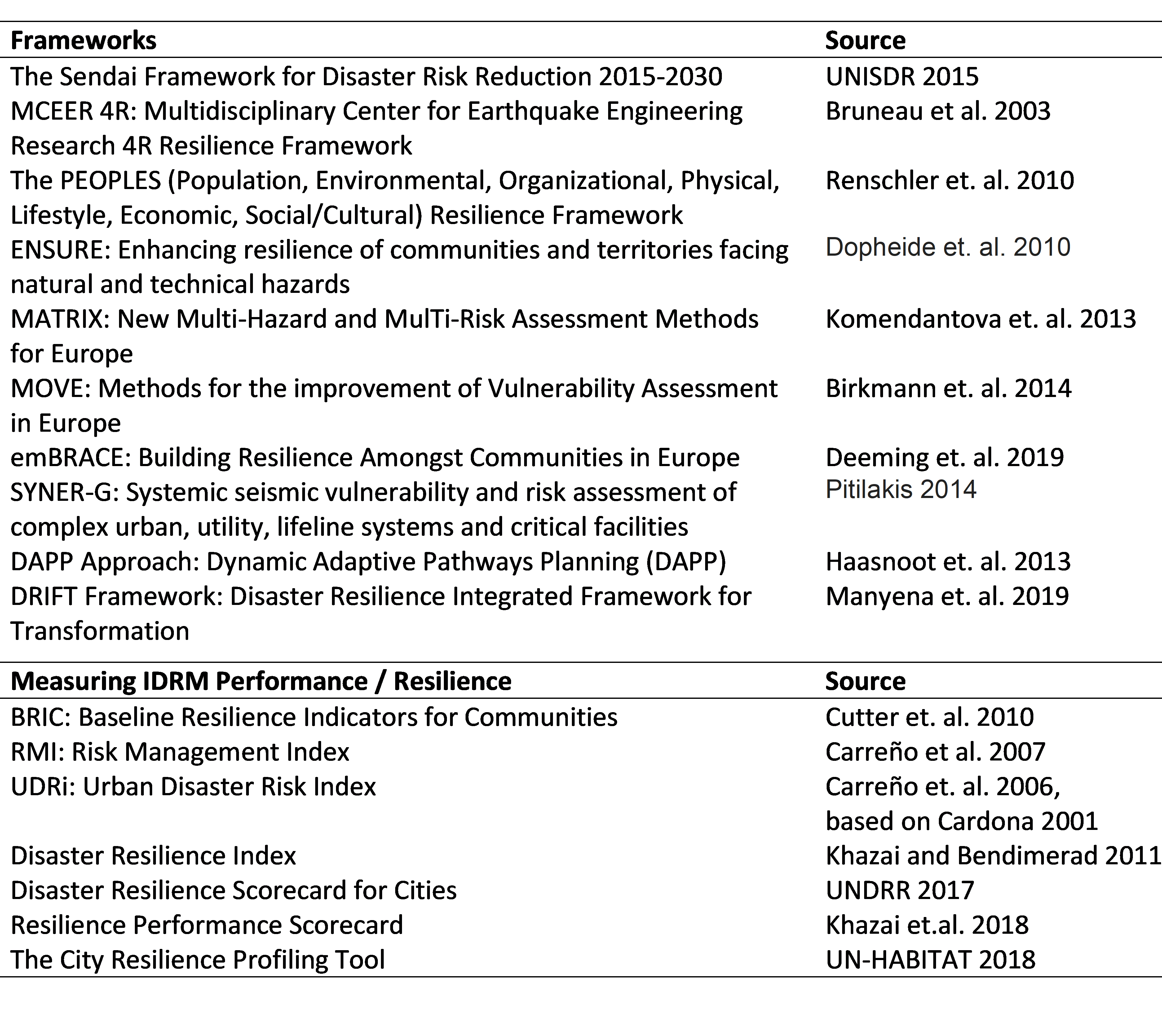Multi-Risk Indicators Approach for Urban Resilience Assessment (INCREASE-MIA)
The overarching goal of disaster risk management is to improve safety and security of regions, cities and communities at risk to hazards (Gopalakrishnan and Okada, 2007). Effective disaster risk management requires an integrated, multi-level, multi-stakeholder, dynamic and adaptive approach (Fekete et. al., 2020), which is mainstreamed into the daily functions and services of a city (Bendimerad et al., 2016). Successful mainstreaming of DRM can go further to addressing the root causes that make communities vulnerable to hazards in the first place (Wisner, 2011; Fraser et al., 2016; Carreno et al., 2017).
Integrated Disaster Risk Management requires resilience thinking. This notion is supported by the Sendai Framework for Disaster Risk Reduction 2015-2030 with its main goal to achieve resilient societies. A defining characteristic of a resilient society is the mainstreaming of disaster risk management into all aspects of development (Ranghieri and Ishiwatari, 2014). Ideally, government stakeholders at every level should consider multiple hazards, vulnerability and risk, as well as the interconnection of development and risk. Yet, it can be challenging for government agencies to make sweeping changes, such as incorporating DRM strategies into all aspects of their work.
It is therefore critical to identify those first steps government stakeholders can take that can act as catalysts for transformation towards integrated disaster risk management and resilience thinking. To this end, as part of the first phase of the INCREASE-MIA project, KIT/CEDIM explored entry points for action in existing DRM approaches to help city government stakeholders take the first steps towards mainstreaming DRM. The foundation of this research was a thorough review of existing international IDRM frameworks and indicator approaches. Echoing the conclusions of Cimellaro et al. (2016) and Ameen et al. (2015), we found that there is no there is no widely accepted framework for assessing community resilience. As such, the project aims to develop an integrated indicators approach for urban resilience assessment, which will apply international best practices, while drawing on German experiences. The urban resilience assessment approach will be a critical first step for urban stakeholders to understand opportunities and limitations to integrate disaster risk management into city policy, planning and practice.
The INCREASE consortium is a four-year project funded by the German Federal Ministry of Education and Research (BMBF). The project includes about 20 partner institutions from natural and social sciences, technology, and practice.

Abbildung 1: Ansatzpunkte für ein integriertes Katastrophenrisikomanagement.
Table 1: Key Frameworks & Approaches for Measuring IDRM Performance/Resilience

- Ameen RFM, Mourshed M, Li H (2015) A critical review of environmental assessment tools for sustainable urban design. Environ Impact Assess Rev 55:110–125.
- Bendimerad, F., Zayas, J., Khazai, B., & Borinaga, K. (2016) Building disaster resiliency through disaster risk management master planning. Encyclopedia of Earthquake Engineering, Beer, M., Kougioumtzoglou, IA, Patelli, E., Au, IS-K.(Eds.), Springer.
- Cimellaro GP, Renschler C, Reinhorn AM, Arendt L (2016) PEOPLES: a framework for evaluating resilience. J Struct Eng 142:04016063.
- Fekete, A., Asadzadeh, A., Ghafory-Ashtiany, M., Amini-Hosseini, K., Hetkämper, C., Moghadas, M., ... & Kötter, T. (2020) Pathways for advancing integrative disaster risk and resilience management in Iran: Needs, challenges and opportunities. International Journal of Disaster Risk Reduction, 49, 101635.
- Fleming, K., Zschau, J., & Gasparini, P. (2014) The New Multi-HAzard and MulTi-RIsK Assessment MethodS for Europe (MATRIX) Project-An overview of its major findings. In EGU General Assembly Conference Abstracts (p. 6584).
- Fraser, A., Pelling, M., & Solecki, W. (2016) Understanding risk in the context of urban development: definitions, concepts and pathways. In Cities on a Finite Planet (pp. 49-72). Routledge.
- Gopalakrishnan, C., & Okada, N. (2007) Designing new institutions for implementing integrated disaster risk management: key elements and future directions. Disasters, 31(4), 353-372.
- Ranghieri, F., & Ishiwatari, M. (Eds.). (2014) Learning from megadisasters: lessons from the Great East Japan Earthquake. World Bank Publications.
- UNISDR - United Nations International Strategy for Disaster Reduction (2015) Sendai framework for disaster risk reduction 2015–2030.
- Wisner, B. (2011) Are we there yet? Reflections on integrated disaster risk management after ten years. IDRiM Journal, 1(1), 1-14.

